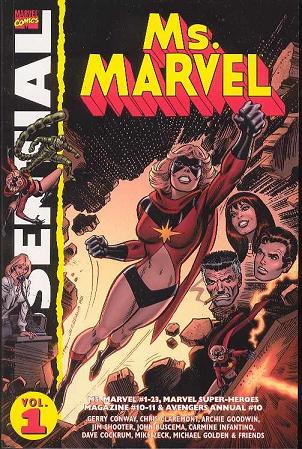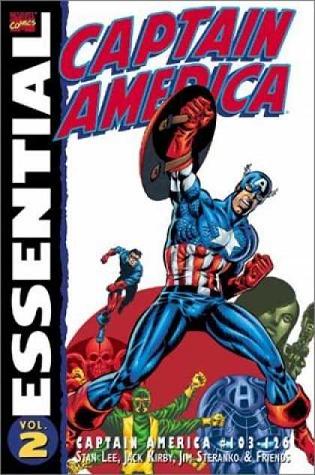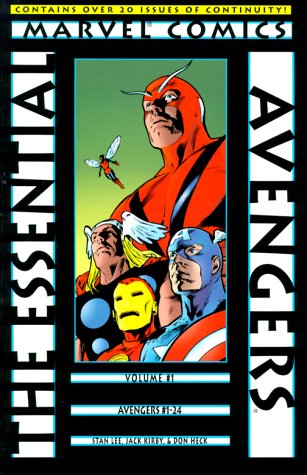
Essential Ms Marvel 01
Gerry Conway, Chris Claremont, Jim Mooney and friends
Reprints: Ms. Marvel 1-23 and more (January 1977 – April 1979)
Get this for: seventies feminist superheroics — Four stars
Now for a complete change of pace, from the heart of the Silver Age taking a giant leap forward into the Bronze Age, long after the people who had laid the foundations of the Marvel Universe had left (and had come back and left again) and some of the creativity and magic had gone out of it. The mid to late seventies were a rough patch for both Marvel and DC, as the old newsstand distribution networks were in upheaval, inflation and economic depression made comics expensive and there was little room to experiment with new titles. So what you get is attempts to play it safe, through either cashing in on some trend or by creating a spinoff — Ms. Marvel is a combination of both: a spinoff of Captain Marvel and an attempt to cash in on the resurgence of second wave feminism, as seen through a comics prism. Despite this the title would last barely two years, being canceled with #23 and with the last two issues, already prepared only seeing print two decades later, in the early nineties Marvel Super-Heroes Magazine.
I don’t know why M.s Marvel failed the first time around: perhaps it could never find an audience out on the newsstands, or people didn’t buy it because it featured a girl (Marvel never having had much luck with female headliners) or just because not enough newsstands stocked it. But one thing I know, quality couldn’t have been the issue. True, it took a couple of issues for Ms. Marvel to find its feet, but once Chris Claremont comes onboard with issue 3 it settled into a nice rhythm. I’ve certainly read much worse titles from that time which were much more succesful.
Ms. Marvel is Carol Danvers, an old supporting character from the sixties Marvel Captain Marvel series, reintroduced in Ms. Marvel as the eponymous superheroine, in the first three issues suffering from amnesia and not knowing she’s Carol. Carol meanwhile gets a job as the editor of Now Magazine, Jolly Jonah Jameson’s woman’s magazine. He wants the traditional subjects: cooking, fashion, gossip, she wants it to make a hardhitting, proper news magazine: soap opera gold, though as per usual with superhero jobs it plays second fiddle to Carol’s other career and its complications.
The whole amnesia/two people angle doesn’t really work and is quickly abandoned once Claremont takes over the writing. He does keep the conflict between Carol and Ms. Marvel however, each with a distinctive personality and not always liking the other that much. Personally I never like this sort of forced conflict or handicap so I’m glad to see this slowly disappearing over time here.
On the supervillain side of things, Conway introduces A.I.M. as a recurring foil and Claremont keeps them around, as well as adding MODOK to the mix. Other established villains, including the Scorpion, obscure X-Men foe Grotesk as well as a couple of badniks from the old Living Mummy series from Supernatural Thrillers also appear. Claremont had a knack for getting tough, physical threats for Ms. Marvel to actually beat with her fists like any other strong male hero would do, rather than the usual non-physical threats reserved for superheroines. There are few original creations here, with Deathbird introduced in #9 and Mystique from #16 the most significant, Claremont using both of them in Uncanny X-Men later on. For the most part however Ms. Marvel is mutant free.
But Claremont was leading Ms. Marvel into that territory though, through the long running subplot of some unknown enemy (which turned out to be Mystique) targeting both Carol Danvers and Ms. Marvel. However Ms. Marvel before that subplot reached fruition and it took Avengers Annual #10 two years later to tie up these loose ends. That one starts with Carol being thrown off the Golden Gate Bridge, rescued by Spider-Woman (who Claremont was also writing) and brought to Prof Xavier to be examined mentally. Meanwhile the Brotherhood of Evil, led by Mystique attack the Avengers and its newest member Rogue turns out to have stolen Carol’s powers.
Apart from housecleaning however and revealing the final fate of Ms. Marvel Claremont had an ulterior motive for writing this annual. Between the end of her own series and the annual Ms. Marvel had been a member of the Avengers and in a particularly bad storyline had been raped and impregnated (all off panel), gone through the full pregnancy and given birth in a day to a boy who turned out to be her rapist, using her to be able to live on Earth, but when this fails he takes her with her to Limbo, where they live happily ever after, or so the Avengers think, never having spent a minute to think things through. Claremont had done this, had gotten offended and used the final part of the story to spell it all out. It’s one of the best “fuck you” moments in comics I’ve read.
Claremont would return to Ms. Marvel even later, in the early nineties in the anthology title Marvel Super-Heroes, which reprinted both the final finished but never published issue, as well as a followup bridging the gap between her series and Avengers Annual #10. Here they’re presented in chronological order, before the annual.
The final verdict is that this was a perfectly enjoyable series, nothing much out of the ordinary, but never bad either. The art, first by John Buscema, followed by Jim Mooney, Keith Pollard, Sal Buscema, Carmine Infantino, Dave Cockrum and finally Mike Vosburg is decent to good, but with so many artists in such a relatively short period it’s hard to create a real style for Ms. Marvel. Essential Ms. Marvel vol 1 is a nice view of what a lesser title of the seventies looked like.



